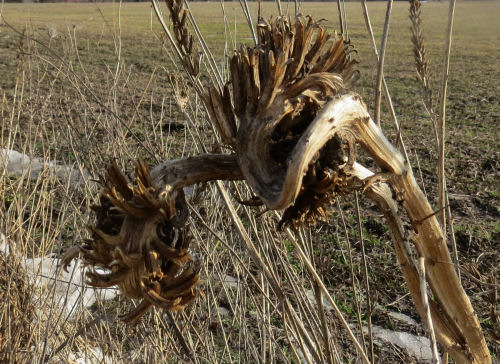I know we are overdue for the January goal report, but there are much more fun things to discuss. I'll do that on a slow day.
The other day, as Sylvia and I were walking we saw a whole line of odd-looking plants.

They were along the edge of a farm field. I went over to take a closer look

Pretty bizarre, eh?

Stay tuned. The seed pods are easy to identify as the common evening primrose, Oenothera biennis.

But something pretty weird is going on with the stems and tips.

This is known as fasciation, and it occurs when there are mutations in the growth tips of a plant. Some plants are more susceptible than others. I was not aware that evening primrose is one that is commonly affected.
The condition can be caused by a permanent genetic change- this is how the cockscomb celosia came to be. It reproduces with the condition in each generation. Usually, the current generation is the only one affected. Insect or mite damage, radiation, or chemical exposure can cause the condition.
I'm thinking that because of the location at the edge of a field this might have been as a result of pesticide use.
You can see pictures of the same plant, still with leaves, fasciated by radiation exposure at Fukushima Diary
See some other plants with the condition at Wayne's World

 | see Evening Primrose in bloom |
| if you like this blog, click the +1 | |
3 comments:
Weird plants indeed!
What a curious thing. Snow continues here. Here's hoping the road firms up.
Hi Furry-
I've seen them when green, and hadn't thought much about it, but after the leaves are down it's even stranger.
Chuck- I've never seen so many all in the same place.
Post a Comment